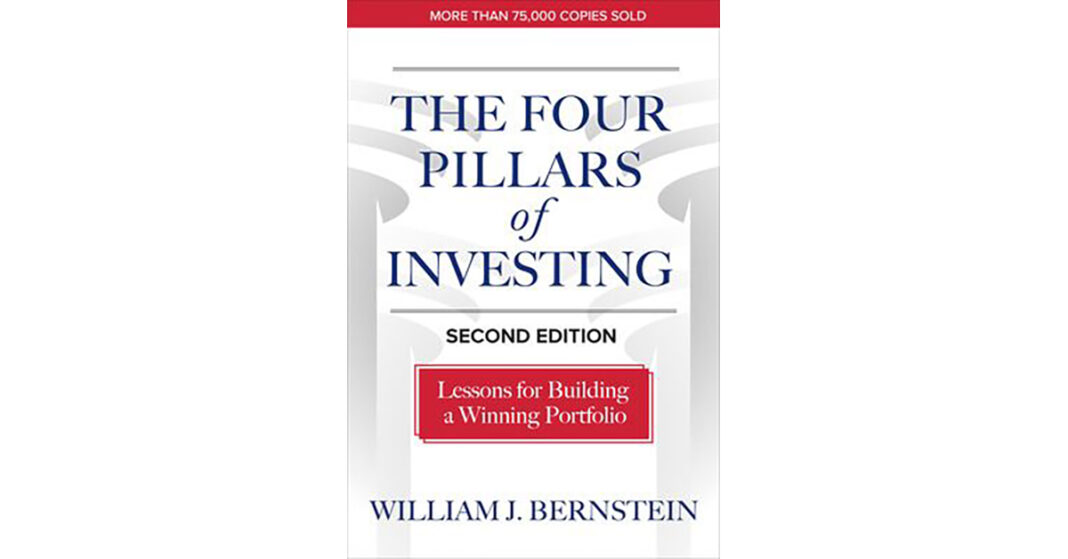The Four Pillars of Investing, Second Edition: Lessons for Building a Winning Portfolio. 2023. William J. Bernstein. McGraw Hill Professional.
In The Four Pillars of Investing, Second Edition: Lessons for Building a Winning Portfolio, William J. Bernstein, a retired neurologist and the cofounder of the investment management firm Efficient Frontier Advisors, provides a comprehensive guide that offers important insights and practical strategies for creating and maintaining a successful investment portfolio. The book, first published in 2002, gives investors a strong foundation in financial principles. Bernstein sets out four key pillars that serve as the bedrock: theory, history, psychology, and business. These pillars together function like the four legs of a chair and are the guiding principles for making good investment decisions.
The first pillar, theory, includes comprehending the underlying concepts and principles that lead to successful investing. Bernstein discusses the need to create a well-diversified portfolio that strikes a balance between risk and return, tailored to individual financial goals, time horizon, and risk tolerance. He explores the intricate relationship between risk and reward, encouraging investors to thoroughly assess their risk appetite before making investment decisions.
The second pillar, history, stresses the importance of analyzing past market trends and historical data because history provides invaluable insights into the behavior of financial markets. History is my favorite of the four pillars. In my opinion, investors should spend more time analyzing financial history to understand what is possible in deriving their views on financial markets, instead of listening to “experts.” Based on historical events, including market booms/busts and recessions, the author illustrates the cyclical nature of markets and highlights the importance of a long-term investing approach. He discusses the implications of market efficiency for retail investors while advocating diversified portfolios as opposed to relying on market timing or individual stock selection strategies.
The third pillar, psychology, highlights the impact of human behavior on investment decisions since the presence of emotional biases can lead to irrational decision making. Bernstein discusses various biases and provides strategies for investors to overcome them. Keeping a disciplined approach to investing and avoiding emotional reactions to short-term market fluctuations are key messages that Bernstein provides throughout the book. Bernstein encourages investors to focus on long-term goals and to develop an investment plan based on solid principles while avoiding emotional decisions driven by noise or short-term trends.
The fourth pillar, business, explores individual companies and their financial performance. Investors should conduct thorough research and gain a deep understanding of the businesses in which they choose to invest. The author stresses the importance of investing in undervalued assets, as well as the impact of fees and expenses on investment returns. He emphasizes the need to minimize costs because they can significantly erode investment performance over time. Bernstein advises investors to seek low-cost investment options that offer broad market exposure at a lower cost than that of using actively managed funds. Although the investment content in magazines, newspapers, social media, and market strategist interviews should be largely ignored, Bernstein recommends reading the Economist’s finance section and listening to the authors of academic papers referenced in this book on YouTube or podcasts, such as Eugene Fama, Zvi Bodie, and Robert Shiller.
He supports his pillars with practical examples, case studies, and historical data, making the content accessible and understandable. The Four Pillars of Investing has received numerous accolades for its comprehensive approach and focus on evidence-based strategies. However, critics have argued that it may be too technical for beginner investors and overlook the possible benefits of active investing.
Private wealth investment professionals can use this book as a way to convey some basic investment concepts to individual clients who are not already familiar with them. Although the author argues that most brokers and advisers occupy the lowest rung in the hierarchy of investment knowledge, these same investment professionals can play a critical role in helping individual investors manage around their own psychology by “staying the course” and not overreacting to short-term fluctuations. This can be an important role played by brokers and advisers because the failure of just one leg of the chair can lead to the demise of the entire investment strategy.
In summary, The Four Pillars of Investing is an important tool for investors looking to design a more successful investment portfolio. Investors can make better financial decisions by comprehending the four pillars of theory, history, psychology, and business. This book highlights the importance of disciplined investing and a long-term diversified approach to managing risk and achieving financial goals. Because of its insights and practical guidance, this book remains a critical resource for those investors trying to navigate the complex world of investing.
If you liked this post, don’t forget to subscribe to Enterprising Investor and the CFA Institute Research and Policy Center.
All posts are the opinion of the author. As such, they should not be construed as investment advice, nor do the opinions expressed necessarily reflect the views of CFA Institute or the author’s employer.
Professional Learning for CFA Institute Members
CFA Institute members are empowered to self-determine and self-report professional learning (PL) credits earned, including content on Enterprising Investor. Members can record credits easily using their online PL tracker.


